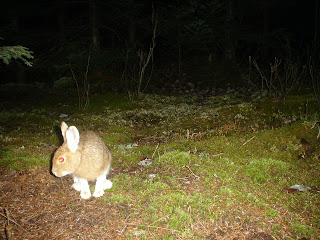A photo series showing the transition of snowshoe hare (Lepus americanus) from brown coat (summer) to a white coat (winter) over a period of weeks in Northern N.H. As expected, showshoe hare are very prevalent in certain locations but in all my time in the woods I hardly see them.
Tuesday, November 27, 2012
Monday, November 19, 2012
Moose and Calf
A couple moose calf pictures from the spring in northern N.H. The first was shot through the mothers legs, the others are self explanatory. Moose in N.H. have declined significantly due largely to winter ticks, and this has resulted in significantly lower moose hunting permits (and thus less revenue). A single moose can easily have > 50,000 ticks which remain on the moose for months to complete their life cycle. Moose in particular are victims of the tick because they cannot reach or groom as well as white-tail deer. It is common to see hair loss or bald spots of moose from scratching, which gives the moose the local nick name "ghost". Moose calfs are the most susceptible to the winter ticks because high densities of ticks literally suck more blood from a calf then it can produce in the spring (April is known as the month of death for moose). Mortality of N.H. moose calfs can be over 70% in bad years while adult mortality rates can be as high as 20%. Luckily this calf looks in good shape, but the true test of survival will be this april.
Sources:
http://www.unbc.ca/nlui/wildlife_diseases_bc/winter_tick.htm
http://www.georgesmithmaine.com/articles/georges-outdoor-news/february/2012/more-moose-fewer-lottery-applicants
Monday, November 12, 2012
Antelope and magpies
The last few pictures from this camera set in Wyoming. An antelope paused to smell the scat (above). Flipping through the pictures it was clear that the scat started to disappear faster then it should decompose. The culprit was a flock of magpies. Magpies are considered to be extremely intelligent birds, but I can't say for sure what they do with the scat after they carry it off.
Wednesday, November 7, 2012
A few pictures taken in Wyoming of a mule deer and a small black bear traveling on a great ridge trail set. The bear was only photographed once but this deer in velvet was photographed multiple times (events). Time of a visit and frequency are important in gathering more information about this animals behavior, home range, etc, but this is a fragment of the information that the photographs from remote cameras can provide. Animal health, activity patterns, predator prey relationships, and powerful educational tools among others are a few of the reasons why remote cameras are growing in popularity with hunters, biologists, and those who love the outdoors. This is the same ridge trail where I photographed a wolf. This camera was only up for 10 days but exemplifies the diversity of wildlife over a ten day period on one trail.
Subscribe to:
Comments (Atom)













